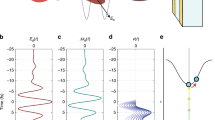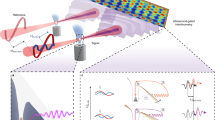Abstract
Attosecond science relies on the use of intense, waveform-controlled, few-cycle laser pulses1 to control extreme nonlinear optical processes taking place within a fraction of an optical period. A number of techniques are available for retrieving the amplitude envelope and chirp of such few-cycle laser pulses. However, their full characterization requires detection of the absolute offset between the rapidly oscillating carrier wave and the pulse envelope, the carrier–envelope phase (CEP). So far, this has only been feasible with photoelectron spectroscopy, relying on complex vacuum set-ups2,3,4. Here, we present a technique that enables the detection of the CEP of few-cycle laser pulses under ambient conditions. This is based on the CEP-dependence of directly measurable electric currents generated by the electric field of light in a metal–dielectric–metal nanojunction. The device holds promise for routine measurement and monitoring of the CEP in attosecond laboratories.
This is a preview of subscription content, access via your institution
Access options
Subscribe to this journal
Receive 12 print issues and online access
$209.00 per year
only $17.42 per issue
Buy this article
- Purchase on Springer Link
- Instant access to full article PDF
Prices may be subject to local taxes which are calculated during checkout



Similar content being viewed by others
References
Krausz, F. & Ivanov, M. Attosecond physics. Rev. Mod. Phys. 81, 163–234 (2009).
Paulus, G. G. et al. Absolute-phase phenomena in photoionization with few-cycle laser pulses. Nature 414, 182–184 (2001).
Paulus, G. G. et al. Measurement of the phase of few-cycle laser pulses. Phys. Rev. Lett. 91, 253004 (2003).
Wittmann, T. et al. Single-shot carrier-envelope phase measurement of few-cycle laser pulses. Nature Phys. 5, 357–362 (2009).
Chipperfield, L. E., Robinson, J. S., Knight, P. L., Marangos, J. P. & Tisch, J. W. G. The generation and utilisation of half-cycle cut-offs in high harmonic spectra. Laser Photon. Rev. 4, 697–719 (2010).
Goulielmakis, E. et al. Single-cycle nonlinear optics. Science 320, 1614–1617 (2008).
Bergues, B. et al. Attosecond tracing of correlated electron-emission in non-sequential double ionization. Nature Commun. 3, 813 (2012).
Dietrich, P., Krausz, F. & Corkum, P. B. Determining the absolute carrier phase of a few-cycle laser pulse. Opt. Lett. 25, 16–18 (2000).
Kling, M. F. et al. Control of electron localization in molecular dissociation. Science 312, 246–248 (2006).
Borot, A. et al. Attosecond control of collective electron motion in plasmas. Nature Phys. 8, 416–421 (2012).
Apolonski, A. et al. Observation of light-phase-sensitive photoemission from a metal. Phys. Rev. Lett. 92, 073902 (2004).
Krüger, M., Schenk, M. & Hommelhoff, P. Attosecond control of electrons emitted from a nanoscale metal tip. Nature 475, 78–81 (2011).
Zherebtsov, S. et al. Controlled near-field enhanced electron acceleration from dielectric nanospheres with intense few-cycle laser fields. Nature Phys. 7, 656–662 (2011).
Kienberger, R. et al. Atomic transient recorder. Nature 427, 817–821 (2004).
Trebino, R. et al. Measuring ultrashort laser pulses in the time-frequency domain using frequency-resolved optical gating. Rev. Sci. Instrum. 68, 3277–3295 (1997).
Iaconis, C. & Walmsley, I. A. Spectral phase interferometry for direct electric-field reconstruction of ultrashort optical pulses. Opt. Lett. 23, 792–794 (1998).
Witting, T. et al. Sub-4-fs laser pulse characterization by spatially resolved spectral shearing interferometry and attosecond streaking. J. Phys. B 45, 074014 (2012).
Holzwarth, R. et al. Optical frequency synthesizer for precision spectroscopy. Phys. Rev. Lett. 85, 2264–2267 (2000).
Reichert, J., Holzwarth, R., Udem, T. & Hänsch, T. W. Measuring the frequency of light with mode-locked lasers. Opt. Commun. 172, 59–68 (1999).
Telle, H. R. et al. Carrier-envelope offset phase control: a novel concept for absolute optical frequency measurement and ultrashort pulse generation. Appl. Phys. B 69, 327–332 (1999).
Xu, L. et al. Route to phase control of ultrashort light pulses. Opt. Lett. 21, 2008–2010 (1996).
Schiffrin, A. et al. Optical-field-induced current in dielectrics. Nature 493, 70–74 (2013).
Cavalieri, A. L. et al. Intense 1.5-cycle near infrared laser waveforms and their use for the generation of ultra-broadband soft-X-ray harmonic continua. New J. Phys. 9, 242 (2007).
Apalkov, V. & Stockman, M. I. Theory of dielectric nanofilms in strong ultrafast optical fields. Phys. Rev. B 86, 165118 (2012).
Kruchinin, S. Y., Korbman, M. & Yakovlev, V. S. Theory of strong-field injection and control of photocurrent in dielectrics and wide band gap semiconductors. Phys. Rev. B 87, 115201 (2013).
Kübel, M. et al. Carrier-envelope-phase tagging in measurements with long acquisition times. New J. Phys. 14, 093027 (2012).
Li, C. et al. Determining the phase-energy coupling coefficient in carrier-envelope phase measurements. Opt. Lett. 32, 796–798 (2007).
Karpowicz, N. & Zhang, X.-C. Coherent terahertz echo of tunnel ionization in gases. Phys. Rev. Lett. 102, 093001 (2009).
Muller, H. G. An efficient propagation scheme for the time-dependent Schrödinger equation in the velocity gauge. Laser Phys. 9, 138–148 (1999).
Bian, X. B. et al. Subcycle interference dynamics of time-resolved photoelectron holography with midinfrared laser pulses. Phys. Rev. A 84, 043420 (2011).
Acknowledgements
The authors thank Y. Deng for technical support and fruitful discussions as well as the Munich-Centre for Advanced Photonics for financial support. A.S. acknowledges the Alexander von Humboldt Foundation and the Swiss National Science Foundation. N.K. acknowledges the Alexander von Humboldt Foundation. Ö.S. acknowledges a Marie Curie International Incoming Fellowship (project NANOULOP, no. 302157). R.K. acknowledges an ERC starting grant.
Author information
Authors and Affiliations
Contributions
T.P.-C., A.S., R.K., R.E. and F.K. conceived and supervised the experiments. A.S., T.P.-C., D.G., O.R., S.M., J.R. and J.V.B. participated in sample design and fabrication. T.P.-C., A.S., N.K., A.A., Sa.K. and Ö.S. performed the measurements. St.K., V.A., M.I.S. and V.S.Y. provided the theoretical description and numerical modelling of the solid-state device for phase detection. T.P.-C. and N.K. performed numerical simulations and analysis of the stereo-ATI measurements. T.W. provided the stereo-ATI phasemeter. T.P.-C., A.S., N.K., St.K., M.K., T.W., V.S.Y., R.K., R.E. and F.K. analysed and interpreted the experimental data. All authors discussed the results and contributed to the final manuscript.
Corresponding authors
Ethics declarations
Competing interests
The authors declare no competing financial interests.
Rights and permissions
About this article
Cite this article
Paasch-Colberg, T., Schiffrin, A., Karpowicz, N. et al. Solid-state light-phase detector. Nature Photon 8, 214–218 (2014). https://doi.org/10.1038/nphoton.2013.348
Received:
Accepted:
Published:
Issue Date:
DOI: https://doi.org/10.1038/nphoton.2013.348
This article is cited by
-
Attosecond electron motion control in dielectric
Nature Photonics (2022)
-
Light phase detection with on-chip petahertz electronic networks
Nature Communications (2020)
-
Sub-femtosecond electron transport in a nanoscale gap
Nature Physics (2020)
-
Attosecond optoelectronic field measurement in solids
Nature Communications (2020)
-
Vanishing carrier-envelope-phase-sensitive response in optical-field photoemission from plasmonic nanoantennas
Nature Physics (2019)



